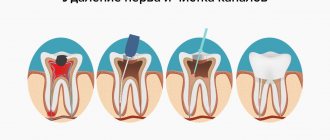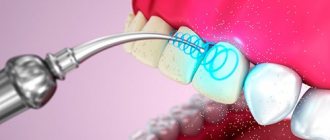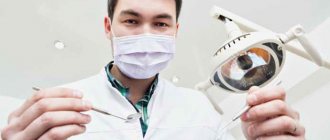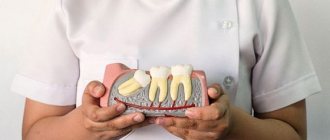Exposing the roots of teeth is a process that is dangerous for the human oral cavity, as it can lead to tooth loss. When the roots are exposed, the amount of gum tissue is reduced and they no longer support the teeth sufficiently. The problem appears as a result of inflammation, improper surgery, and injuries. It can be easily resolved with timely treatment.
Symptoms of exposed roots
Exposing the roots is accompanied by unpleasant sensations. Most patients already suffer from the following problems in the early stages:
- pain when eating hard foods;
- increased bleeding of gums;
- redness of the gums;
- swelling of the gums;
- inflammatory processes;
- causeless discomfort in the oral cavity;
- itching, throbbing.
Important! At the end of development, bad breath may occur. It appears due to necrosis of the gum tissue, and also due to the fact that when exposed, it becomes more difficult to remove particles of clogged food.
At the last stage of development of the problem, the teeth begin to loosen, and the patient experiences severe pain. Bleeding occurs with any mechanical stress, including chewing. Caries or other dental damage may develop because the enamel exposed under the gums is weaker than the enamel that is constantly exposed.
External signs
During the development of exposure, the patient may notice so-called periodontal pockets - these are areas of the neck or root of the tooth that are not covered by gum tissue.
The neck of the tooth is the part that is hidden under the gum. The root is the most “hidden” part, which is located deep in the bone and soft tissues. Normally, only a third of the tooth should be visible - the crown, the visible white part. But when exposed, first the neck becomes visible, and then the roots.
Pockets may be accompanied by reddening of the gums, inflammation and caries. The exposed areas appear as yellow plaque because the neck of the tooth is usually darker than the exposed crown enamel.
After tooth extraction, the neighboring tooth hurts - why and what to do?
Most people perceive the intervention of a dental surgeon as a guarantee of rapid cessation of pain. However, unfortunately, their expectations are not always met. For example, sometimes there are complaints that after tooth extraction the neighboring tooth hurts. This phenomenon can occur for several reasons.
- Any surgical procedure in the oral cavity is accompanied by injury to the tissues of the jaw and gums. The discomfort may be similar to toothache. This phenomenon does not require medical intervention and goes away on its own within a few days. Patients especially often complain that after wisdom tooth removal, neighboring teeth hurt. The fact is that third molars are often difficult to remove.
- An inflammatory process may also begin in the hole due to infection or a violation of the integrity of its walls. Alveolitis occurs, which is characterized by sharp pain in the gums (sometimes perceived as pain in neighboring units of the dentition) and requires urgent treatment.
- In addition, the loss of the integrity of the dentition leads to a gradual shift of neighboring units towards the missing one. This can also be accompanied by unpleasant sensations and, in addition, leads to malocclusion and a whole range of dental problems. This is why experts recommend not postponing prosthetics for long.
- Finally, sometimes the source of pain can be a carious process in a tooth, unnoticed by the doctor during the removal of the neighboring one. Of course, the pain that arises for this reason will not go away on its own. It is necessary to contact a dentist as soon as possible to eliminate the carious cavity and close it with a filling.
Be that as it may, only a doctor can accurately answer the question of why the neighboring tooth hurts after tooth extraction.
If the pain is severe and does not go away after a few days, you should immediately see a dentist.
The specialist will check whether there are any chips left in the socket, whether an inflammatory process has developed, and will also examine the adjacent dental units and soft tissues.
If you have a toothache, you can visit DentaLux-M dentistry. Make an appointment right now by calling the phone number on the website!
You can definitely talk about the seriousness of the situation after the examination. An approximate picture of what is happening is built by analyzing the symptoms.
Symptoms
- It's a dull pain;
- pain is felt exclusively upon palpation or upon contact with hard objects;
- strong pain;
- pain is accompanied by swelling of the cheeks;
- pain signs and temperature;
- swelling of the hole from which the tooth was removed;
- the occurrence of pain after the end of anesthesia;
- jaw pain;
- presence of a bruise at the site of tooth extraction.
Causes of pain
The reasons should be considered as typical and atypical. Typical ones include:
- pain on contact where the tooth was is a quickly passing phenomenon;
- Swelling of the gums is a common consequence after tooth extraction. But when this phenomenon is detected, greater attention to oral hygiene is required. Decoctions or infusions are used as a rinse;
- pain after recovery from anesthesia usually lasts 2–5 hours. But a longer period is not excluded. If it hurts a lot, take a painkiller. According to the rules, dentists warn about possible consequences, so they prescribe medications themselves;
- a bruise is the result of pressure applied during tooth extraction. You should not apply a cold compress to your teeth, as this can cause inflammation of the nerves. To quickly get rid of a hematoma, special ointments are used. But, in any case, the bruise is temporary;
- Pain in the jaw after tooth extraction is considered natural; after all, tooth extraction is an operation performed by dentists.
The listed signs are normal and should not cause concern. With such pain, it seems to a person that the neighboring teeth hurt, but in fact, the pain covers a certain area, the center of which is the place after the extracted tooth.
If neighboring teeth hurt after tooth extraction and there are purulent formations, this is a sign of infection. Before being examined by a dentist, you can reduce pain by rinsing with chamomile infusion and taking painkillers. But a visit to the dentist cannot be postponed, even if the pain completely disappears.
The temperature indicates the characteristics of the immune system, that is, the body’s protective reaction to surgery occurs. In addition, the possibility of an inflammatory process cannot be ruled out. Accordingly, the appearance of temperature is a reason for repeated examination.
In dental practice, there have been cases when patients, after tooth extraction, noticed pain in the area of other teeth, although they had not bothered them before.
But, if the removal is carried out by a competent specialist, then he will definitely notice the problems of all teeth, because an x-ray of the oral cavity is first taken.
The optimal solution for those who cannot hesitate to resolve a dental issue is one-stage implantation - as an opportunity to install an implant in the socket of an extracted tooth and immediately “load” it with a crown. Thus, tooth extraction will remain a secret to everyone except you and your implantologist! Read more One of the most progressive methods of modern implantation is basal.
Its essence lies in the installation of monoblock implants in the basal layers of tissue of the dental system. Result: a higher probability of engraftment, no need for bone augmentation even in case of bone deficiency. Read more Regardless of when the tooth was removed, express implantation is an opportunity to restore it in a minimum number of doctor visits (1-2).
Teeth begin to hurt suddenly and often at the most inopportune moment. A person has no choice but to go to an appointment with a dentist, after examining the oral cavity, he makes a decision on treatment or removal.
Everything seems to be fine, the diseased tooth has been removed, but after some time, after the anesthesia wears off, the painful sensations return, but only to the adjacent tooth, and the question immediately arises, why is this happening and how long will it last?
If a neighboring tooth hurts after tooth extraction, this may mean the following:
- During surgical intervention into the roots of a tooth, tissue and gum damage occurs; often the doctor has to suture the gum and because of this, the pain can spread to neighboring teeth.
- The process of infection spreading to neighboring segments that are located next to the infected wound has begun; pain may be accompanied by fever, inflammation of the cheeks and gums, and pain in the head.
- During the extraction operation, the roots of an adjacent tooth were damaged or a piece broke off from it. If this happens, you need to make a second visit to the dentist's office.
- Painful sensations may occur due to negligence of the doctor’s recommendations.
After tooth extraction, the occurrence of pain is a natural reaction and normally this will occur for three days.
These sensations appear due to the fact that during surgery, damage to the gums and soft tissues occurs. If pain does not leave a person for a long period of time, it is necessary to contact a dental clinic as soon as possible.
Duration of pain
During tooth extraction, damage to the gums occurs; after the procedure, neighboring teeth begin to shift and touch the site of injury and because of this, pain occurs, usually it is aching and goes away after 3-5 days.
If the removal was more complicated, the pain may not leave the patient for up to half a month. It may be accompanied by headaches, swelling in the cheek area and swelling of the gums.
In many cases, all symptoms may go away on their own after some time.
We suggest you read: After tooth extraction, gums hurt: what to do with severe pain after wisdom tooth removal
How to relieve pain?
Usually the painful sensation goes away on its own after a few days, but if this does not happen or the pain is hard to bear, you can use some remedies to alleviate the condition.
Doctors prescribe painkillers to patients after surgical procedures. In addition to medicines, you can use a variety of baths.
The following methods can be used to relieve pain:
- If you suffer from severe pain, you can take medications prescribed by the doctor or other painkillers, the dosage depends on the intensity of the pain. Ketanov is the most popular tablet for pain, two tablets are taken. every 6 hours. If the pain is acute, you can take Nurofen or Ibuprofen several times during the day. You cannot take pills at your own discretion; you must always follow the doctor’s recommendations or instructions.
- For the first few hours after removal, you can apply cold compresses to the cheek area. Using this method, you can get rid of unpleasant sensations, calm your nerves and promote the fastest healing of wounds.
- After several days, you can make baths with a mixture of baking soda, salt and 3-4 drops of iodine. Rinse as often as possible throughout the day.
- You can use baking soda and salt for the same procedures, either together or separately from each other. Such procedures are carried out at least three times a day.
- Decoctions of medicinal plants contribute well to wound healing. To prepare, you need to make a decoction of St. John's wort or chamomile and leave for a little while. It is not worth rinsing the mouth because the hole is washed out; various types of complications may arise. Instead of rinsing, you just need to put the broth in your mouth and hold it for a while, then spit it out.
- You can take antihistamine medications. With their help, the effect of painkillers is enhanced and swelling is reduced. In addition, these medications have a hypnotic and sedative effect.
How does the process of tooth root exposure occur?
When exposed, the patient first notices unpleasant changes in the structure of the gums . They either become inflamed or begin to hurt. As a result of inflammation or constant mechanical pressure (including from a brush that is too hard), soft tissue wears off and disappears. They do not grow back until the root cause of the deviation is eliminated.
So, after the soft tissues begin to gradually disappear, the middle part of the tooth, the neck, is exposed . It is thinner than the tooth itself and has a yellowish tint.
The last stage is root exposure. In order for it to become visible, most of the gum tissue must be gone. Usually, if the roots of one tooth are exposed, then the neighboring ones also suffer, their neck becomes visible.
Why is nudity dangerous?
If the roots are exposed, it leads to various disorders. Already at an early stage, the patient begins to suffer from unpleasant consequences:
- frequent bleeding;
- pain when eating and brushing teeth;
- inflammation of the gums, which makes it difficult to speak and eat;
- violation of the aesthetic appearance of teeth.
Further consequences only become more serious. As a result of neglected exposure, teeth may fall out. Then you will have to replace them with full-fledged dentures with roots, and not just put a crown on top. Inflammation may occur in the socket of a lost tooth. If the resulting gap is not filled in time, the adjacent teeth will gradually close it, and the evenness of the row will be greatly disrupted - the teeth will squint, tilt, it will become uncomfortable to chew and unpleasant to smile.
At the middle stage, side diseases may occur due to the fact that it becomes difficult to brush your teeth (and it hurts):
- caries;
- pulpitis (due to exposure, the roots become more sensitive to cold);
- tartar;
- periodontitis;
- etc.
Reasons for rejection
Plaque at the roots is one of the reasons for the development of pathology.
Often, exposure develops due to improper oral care.
The most common reason for the disappearance of normal gum tissue is the appearance of plaque on the upper (or lower, associated with the gum) part of the teeth, in which bacteria multiply.
Microorganisms gradually lead to gum inflammation. The infection spreads and the gum tissue begins to die due to damage.
Important! They heal incorrectly - instead of soft tissue, too thin epithelium appears.
But even with proper dental care, exposure can occur. Thus, people who are especially prone to destruction of soft tissues near the tooth are patients with malocclusion. If it is incorrect, then the teeth themselves can act on the gums and gradually wear them away, constantly injuring them.
Risk factors
Tartar
At risk are those people who, for various reasons, have a small gap between the gum and tooth. The most common causes of a gap are tartar or mechanical trauma.
When tartar occurs, a mineral build-up occurs, which can disrupt the structure of tissues and “pull” the gums away from the neck of the tooth. Plaque easily penetrates into the resulting gap, which is almost impossible to clean out. Most patients do not even notice that food particles have gotten under the gums. The result is inflammation.
Attention! With mechanical trauma, the integrity of the gum tissue can also be compromised. It will either heal incorrectly or become inflamed, which will expose not only the neck, but also the root of the tooth.
Recommendations
After the surgical procedures, the doctor will give the patient some recommendations, if followed, the rehabilitation period can be facilitated.
For the fastest healing of the gums and the fastest relief from pain, you must adhere to the following recommendations:
- If the tooth is removed without possible complications, after the operation you should immediately take the painkiller recommended by the dentist; you should take the drug while the anesthesia is still in effect. In many cases, this method helps to avoid pain.
- After tooth extraction, you should try not to bend over or engage in physical activity to avoid blood flow to the extraction site, otherwise bleeding may begin.
- It is necessary to refrain from eating spicy, hot food and drinks, and also temporarily give up alcohol, smoking, and visiting baths and saunas.
- After the operation, it will be better if the patient sleeps or rests. You should not eat on the side where the tooth was manipulated, and try to strain and load your jaw as little as possible.
- If the doctor allows, you can apply a cold compress (for 15 minutes) to the side where pain is present.
- You should not rinse your mouth, as this may wash out the blood clot from the socket and cause the formation of alveolitis.
- Teeth should be brushed as usual, but the extraction site should be treated with special care.
Read also: Removal of an impacted tooth
After tooth extraction, patients are almost always accompanied by painful sensations. There is no need to worry about this, the pain will go away on its own after some time.
If the pain does not go away, but only increases and is accompanied by various symptoms, you need to consult a dentist as soon as possible, this will be the best option in solving the problem.
Treatment
Gumplasty (used in advanced cases).
Therapy is prescribed depending on what caused the deviation. Let's look at the most common problems:
- Incorrect care. There is no need for surgery or dentistry here - it is enough to explain to the patient how to brush their teeth correctly.
- Tartar. Dental treatment is applied.
- Inflammation of gum tissue. Medicines are prescribed and, if necessary, surgery is performed.
Treatment is also prescribed depending on the stage of development of the exposure. In the initial stages, it is enough to eliminate the root cause and prescribe a healing ointment for the gums. In advanced cases, an artificial tooth can be made or gum tissue transplanted.
Dental
Dental treatment may be as follows:
- Ultrasound removal of tartar
Removing plaque from cheeks, teeth, tongue. This eliminates the harmful environment that predisposes the gums to inflammation. The plaque is first scraped off and, if necessary, removed with ultrasound. Then the patient is explained how to brush his teeth correctly and is given a softer brush.
- Tartar removal. After removing the stone, you need to carefully care for its former location. This task lies on the shoulders of the patient himself.
- Bite correction. If the gums are injured due to improper jaw position, braces are placed or surgery is performed to correct the malocclusion.
- Grinding or replacing a filling. Sometimes protruding parts of the filling lead to tissue injury.
If tartar, plaque or another dental problem accompanies gum inflammation, move on to medicinal methods.
Medication
Drug treatment involves the use of three types of drugs. This:
- Antiseptics. Cleanses the mouth and kills bacteria. A mouth rinse is usually sufficient.
- Antibiotics. They destroy highly developed bacteria and stop inflammation.
- Healing agents. These can be gels, ointments, rinses, pastes containing special substances.
Reference! If you have gum inflammation, you should also avoid abrasive toothbrushes with a high degree of hardness.
Traditional methods
Gum massage
In the early stages of the disease, you can use traditional methods.
Massage will help with pain. It should be carried out 1-2 times a day with clean hands. Massage speeds up blood circulation, helps strengthen tissue and sometimes saves gums from decay.
To remove pathogenic bacteria , you need to rub herbal pastes or rinse your mouth. You can rub crushed mint leaves. Rinses are made based on calendula and eucalyptus. If you use eucalyptus or mint rather than an alcoholic tincture of calendula, you will need to add vodka to the tincture and keep it in the refrigerator for a week. Use after lunch and dinner.
Exposure of the neck and root of the adjacent tooth
- You need to make sure that all chips have been removed from the wound from the figure eight and thoroughly processed.
- You cannot rinse your mouth on the day of removal, because you need to allow a blood clot to form in the hole, which will prevent infections.
- Strictly adhere to all the recommendations given by the dentist, that is, refrain from solid and hot foods, forget about smoking for a while and do not drink alcohol.
- Undergo the postoperative treatment prescribed by the doctor, without neglecting the course of antibiotic therapy.
- If after a week the entire dentition continues to ache and ache, the swelling does not subside, a strange taste and bad breath have appeared, then it is better to go for a second visit to the doctor.
When the effect of anesthesia wears off, the patient begins to suffer from pain; many people experience this. The doctor prescribes painkillers based on the individual characteristics of the client’s body. However, there are a number of medications that are suitable for many people. Their dose is prescribed depending on the intensity of pain.
For difficult removal and acute pain, Xefocam Rapid is often prescribed, which is used at sixteen milligrams, but not more than a couple of times a day. Ibuprofen and Nurofen are gentle medications. You can drink them two to three times a day, six hundred to eight hundred mg. When using each drug, you should adhere to the strict dosage prescribed by the doctor or indicated in the instructions for the selected painkiller.
You can rinse your mouth after surgery only on the second day. There are proven and effective drugs that help relieve pain, promote rapid healing of the socket and have an anti-inflammatory effect:
- Chlorhexidine;
- Furacilin;
- Manganese;
- Miramistin;
- decoctions of chamomile, calendula;
- saline solution
Recommendations
After the surgical procedures, the doctor will give the patient some recommendations, if followed, the rehabilitation period can be facilitated.
For the fastest healing of the gums and the fastest relief from pain, you must adhere to the following recommendations:
- If the tooth is removed without possible complications, after the operation you should immediately take the painkiller recommended by the dentist; you should take the drug while the anesthesia is still in effect. In many cases, this method helps to avoid pain.
- After tooth extraction, you should try not to bend over or engage in physical activity to avoid blood flow to the extraction site, otherwise bleeding may begin.
- It is necessary to refrain from eating spicy, hot food and drinks, and also temporarily give up alcohol, smoking, and visiting baths and saunas.
- After the operation, it will be better if the patient sleeps or rests. You should not eat on the side where the tooth was manipulated, and try to strain and load your jaw as little as possible.
- If the doctor allows, you can apply a cold compress (for 15 minutes) to the side where pain is present.
- You should not rinse your mouth, as this may wash out the blood clot from the socket and cause the formation of alveolitis.
- Teeth should be brushed as usual, but the extraction site should be treated with special care.
After tooth extraction, patients are almost always accompanied by pain. There is no need to worry about this, the pain will go away on its own after some time.
If the pain does not go away, but only increases and is accompanied by various symptoms, you need to consult a dentist as soon as possible, this will be the best option in solving the problem.
During surgery, soft and hard tissues are forced to be injured. In addition, the dentition on the operated gum shifts, so the socket begins to be compressed under the influence of neighboring molars.
As a result, a pain syndrome of a temporary nature appears, and it goes away within five to six days.
There are cases when, after the removal of the third molar, all neighboring teeth hurt for other reasons:
- Due to mechanical damage. Sometimes, by an absurd accident or due to the unprofessional approach of a doctor, a piece of a neighboring tooth breaks off, the periosteum is damaged, or part of the root becomes exposed. If you notice this, you should immediately go to the doctor.
- An infectious-inflammatory process began at the site of the wound. Often this phenomenon can affect several molars that are located nearby. Along with unpleasant sensations regarding neighboring teeth, body temperature begins to rise, headaches, and swelling of the gums and cheeks. With such complications, the pain does not go away for a very long time.
Pulling out an extreme molar is a complex procedure, but it may not be as painful or time-consuming as many expect. Simple removal takes from one to fifteen minutes and includes several steps:
- The patient is examined: blood pressure is measured, the presence of allergies to medications and other diseases is determined. Actions are necessary to ensure that the anesthesia process and the removal itself do not harm human health.
- Anesthesia is administered. The upper jaw is anesthetized faster than the lower jaw, since the latter contains a larger number of nerve endings and blood vessels. Some clinics practice general anesthesia.
- The molar is removed using forceps and an elevator. With a simple extraction option, the gums do not need to be cut or drilled.
If the removal was carried out in the presence of an inflammatory process or exacerbation of periodontitis, then the wound is treated with antiseptic and anti-inflammatory drugs for prevention. Fast healing is also facilitated when the doctor brings the edges of the hole closer together - this can help avoid bleeding and reduces the risk of inflammation. It is worth noting that such complications are very rare.
Those people who have had to deal with a difficult removal will never forget the pain from the process, the duration of the operation, the large amount of blood, the difficult recovery and healing of the hole.
You should be prepared for a difficult figure eight extraction if it has twisted or curled roots. The location of the extreme molar also does not allow it to be removed using the traditional method.
So, the complex removal is as follows:
- The patient is prescribed an X-ray of the molar so that the doctor can see it completely in the photo and plan the course of the operation. Health information is collected.
- Anesthesia is administered with drugs that cannot cause allergies. They must be long-acting, because the operation can last up to an hour and a half.
- The gums are cut, the roots are separated using a drill and gradually removed from the socket. The wound is washed with antiseptics and anti-inflammatory agents and then sutured.
If the operation was carried out as carefully as possible, then pain in neighboring teeth is only a temporary phenomenon that must be endured. More often it goes away within a week.
If you have the feeling that all your teeth hurt, then this is normal, because the dentition has shifted slightly after the operation.
We suggest you read: How long does it bleed after wisdom tooth removal: how to stop the bleeding
Modern dentistry allows tooth extraction to be performed as painlessly as possible and without subsequent complications.
However, in some cases, pain cannot be avoided. Removing wisdom teeth is especially difficult due to the inaccessibility and tight fit of the tooth.
Despite the use of strong painkillers, acute pain is possible during the operating and postoperative period. This is due to the complexity of the operation and possible provoking factors, including:
- the presence of an inflammatory process;
- long-term use of painkillers before surgery;
- state of alcohol or drug intoxication;
- individual characteristics of the body;
- tooth ingrowth into the soft tissues of the oral cavity.
In some cases, tooth extraction requires dissection of the gum. This is due to improper formation of the diseased tooth.
For example, wisdom teeth can come out at an angle, catching neighboring teeth, loosening their root system and causing severe pain due to pinched nerve endings. In this case, the tooth must be cut and removed step by step. The hole and incisions are sutured to speed up the healing process and avoid infection.
There are other factors that can complicate the removal surgery:
- complete destruction of all teeth;
- curvature of roots;
- increased fragility;
- germination into the gum without reaching the surface.
In all these cases, an incision is made in the gum, which can lead to complications due to infection or poor quality of the operation.
If your gums hurt after a tooth has been pulled out, this may indicate tissue inflammation.
It is especially important to ensure that after surgery the blood clot does not wash out, which protects the socket from infection and promotes rapid healing.
The clot prevents food from entering the damaged area, which can cause inflammation. To prevent the blood clot from being washed away, you should refrain from eating, after which you can only eat soft foods.
Pain after a tooth is pulled out is normal. As the anesthesia wears off, aching pain occurs. Usually the pain goes away within 24 hours; with more complex removal, pain can persist for several days.
You should consult a doctor if the pain is of the following nature:
- pulsation is felt in the affected area;
- suppuration appears;
- pain spreads to the cheek and nearby tissues;
- swelling is observed (the gums become swollen);
- body temperature rises;
- an unpleasant odor appears.
Possible complications
Deformation of the dentition due to exposed roots.
Various complications may occur during and before treatment. The most common:
- destruction of enamel;
- caries;
- gum necrosis;
- inflammatory process;
- deformation of the dentition.
If gum necrosis and even tooth loss can be easily compensated for with antibiotics and the use of dentures, then a violation of an even row of teeth will be much more difficult to cure. If an empty socket appears due to tooth loss, you need to fill it urgently so that the teeth do not begin to tilt.











